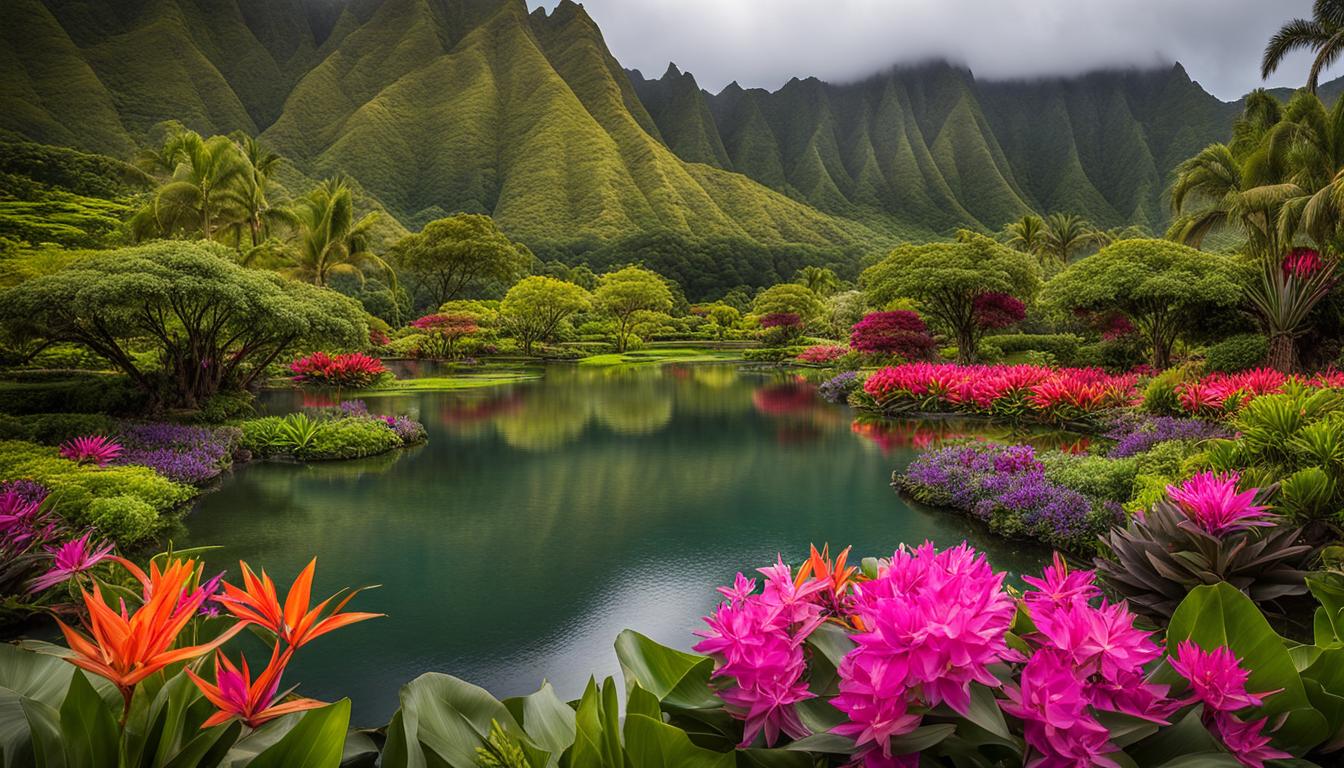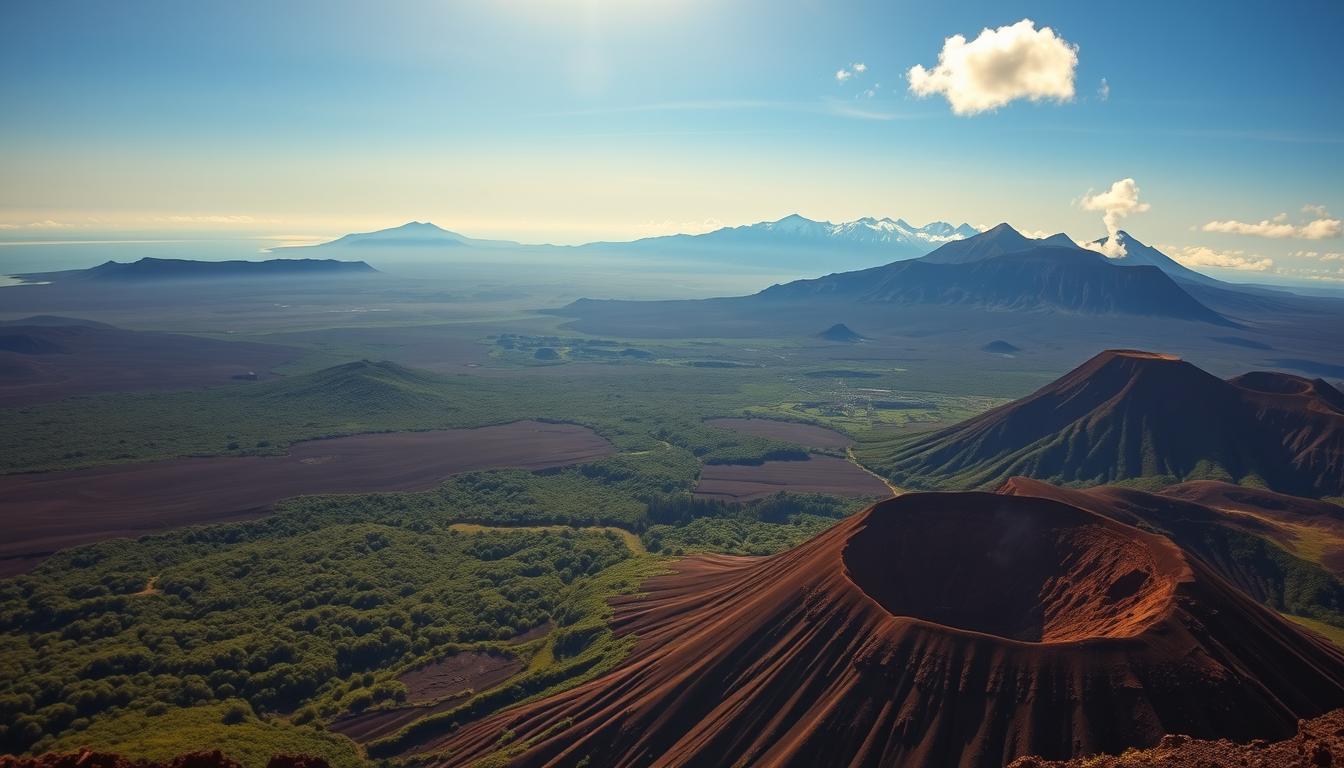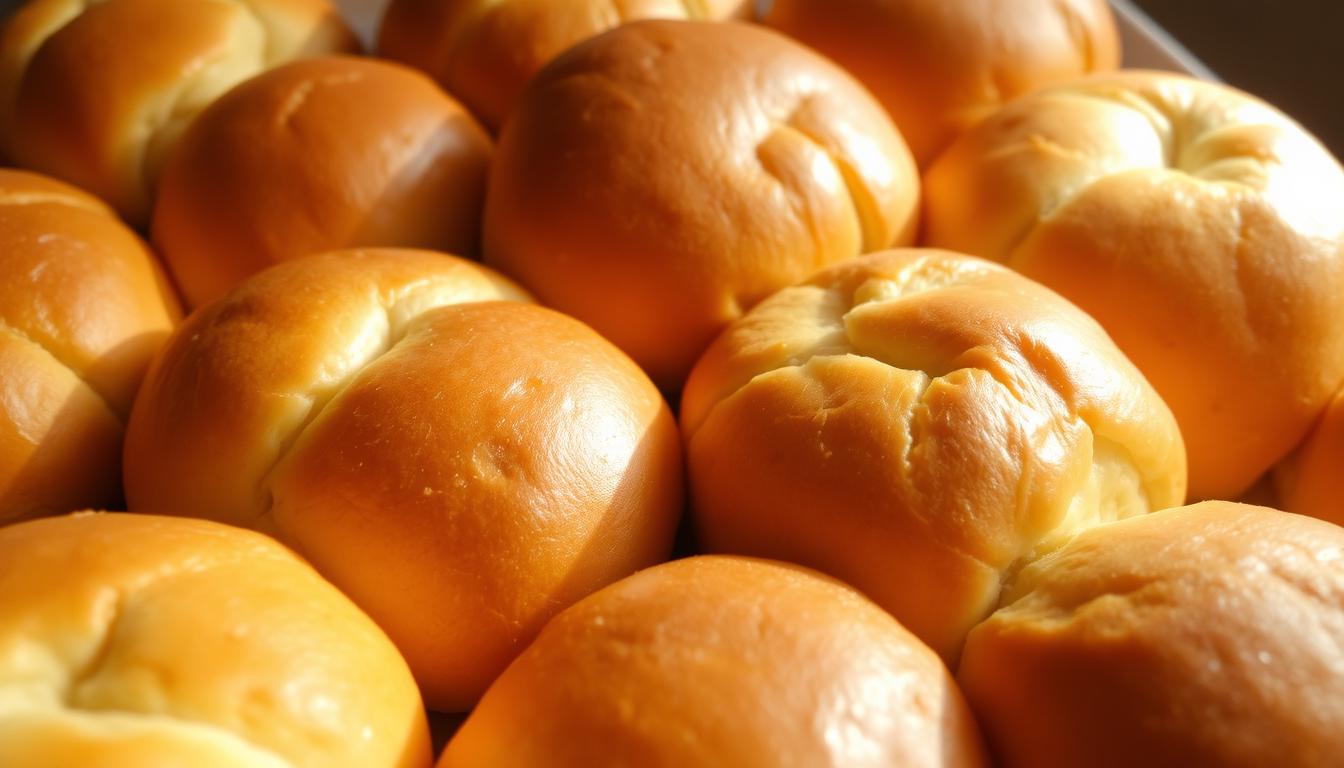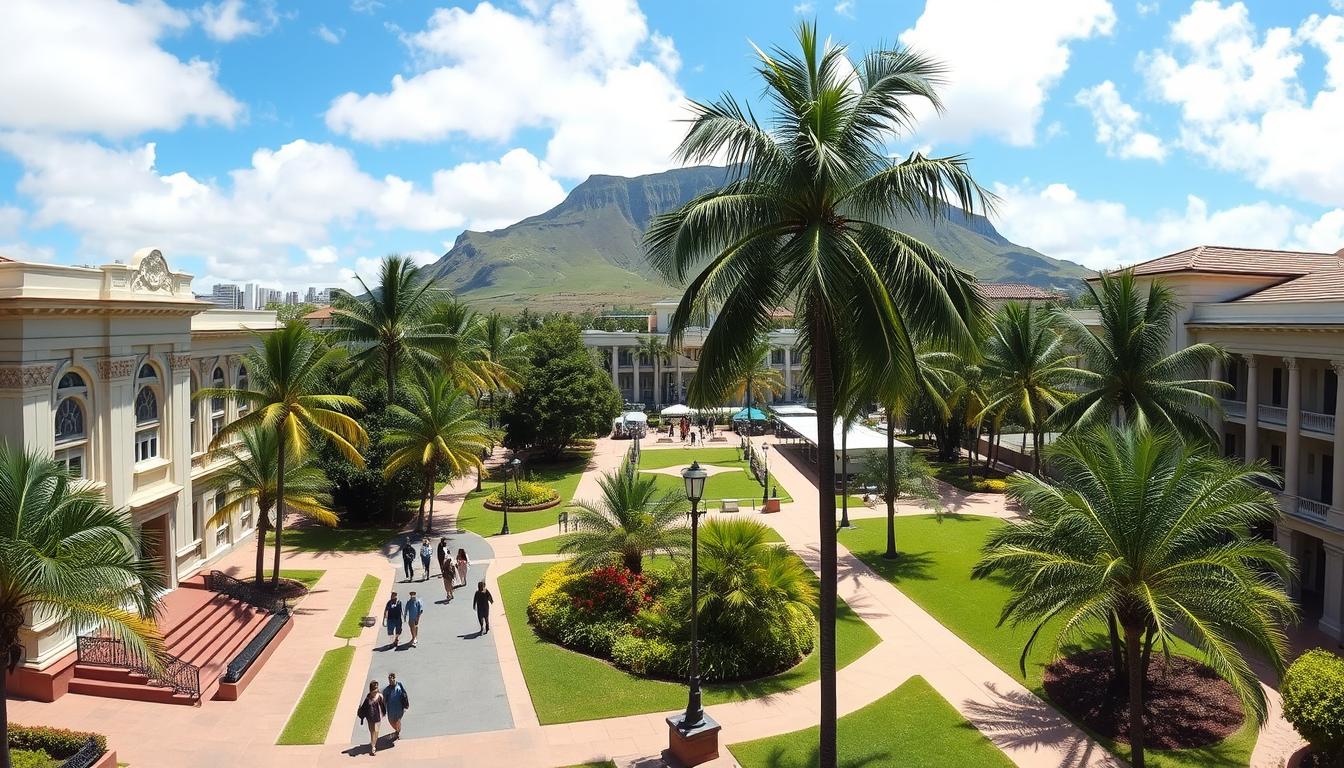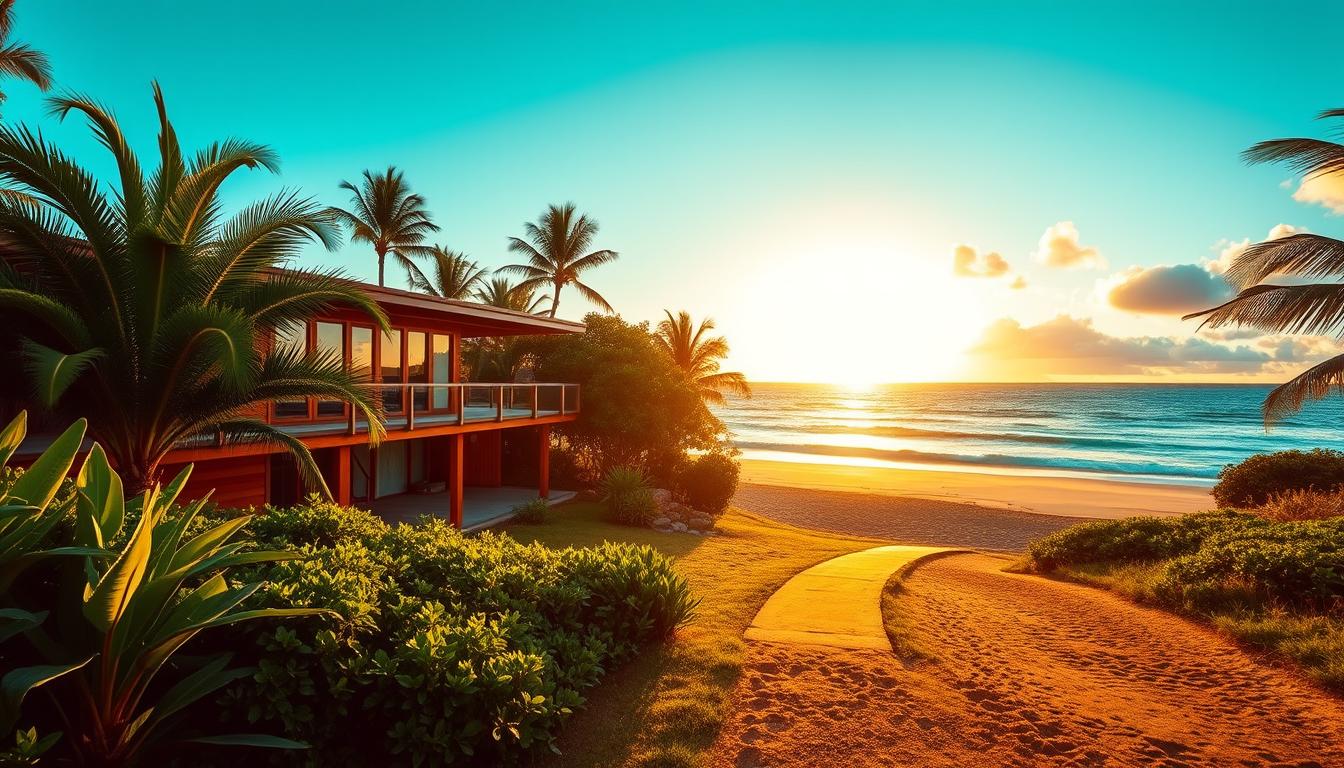Hawaii is a dream destination for photographers, especially during the winter months. Whether you’re looking for stunning landscapes, pristine beaches, or vibrant sunsets, Hawaii has it all. From Oahu to Maui, Kauai to the Big Island, there are countless photography spots to explore. In this article, we will uncover the best photography spots in Hawaii during winter, giving you a guide to capturing the beauty of the islands in the colder months.
Oahu: Ho’omaluhia Botanical Garden
Oahu, the most popular tourist hotspot in Hawaii, offers a diverse range of photography opportunities. One standout location is the Ho’omaluhia Botanical Garden. This expansive botanical reserve with jaw-dropping mountain views provides a picturesque backdrop for capturing stunning shots. The Park Access Road allows for a scenic drive through the garden, with restrictions on leaving the vehicle or stopping for photos. It’s a must-visit spot for photographers looking to capture the natural beauty of Oahu during winter.
Key Takeaways:
- Ho’omaluhia Botanical Garden in Oahu is a standout photography spot with breathtaking mountain views.
- Drive along the Park Access Road to explore the garden’s beauty, but be mindful of restrictions on stopping for photos.
Oahu: Ho’omaluhia Botanical Garden
Oahu, the most popular tourist hotspot in Hawaii, offers a diverse range of photography opportunities. One standout location is the Ho’omaluhia Botanical Garden. This expansive botanical reserve with jaw-dropping mountain views provides a picturesque backdrop for capturing stunning shots. The Park Access Road allows for a scenic drive through the garden, with restrictions on leaving the vehicle or stopping for photos. It’s a must-visit spot for photographers looking to capture the natural beauty of Oahu during winter.
Exploring Ho’omaluhia Botanical Garden
When visiting Ho’omaluhia Botanical Garden, photographers have the opportunity to capture a wide variety of flora and fauna. The garden boasts over 400 acres of lush vegetation, including tropical plants, flowers, and towering trees. Nature enthusiasts will be delighted by the chance to photograph vibrant orchids, colorful birds, and serene ponds.
Best Time for Photography
To make the most of your photography session at Ho’omaluhia Botanical Garden, it is recommended to visit during the early morning or late afternoon. These times offer beautiful lighting conditions, with soft golden hues bathing the scenery. Additionally, weekdays are typically less crowded, providing a more tranquil setting for your photography endeavors.
Tips for Photographers
- Bring a tripod: The low light conditions during sunrise and sunset make a tripod essential for capturing sharp and well-exposed images.
- Experiment with different angles: Explore the garden from various perspectives to find unique compositions that showcase the beauty of the surroundings.
- Pay attention to the weather: Keep an eye on the weather forecast and plan your visit accordingly. Cloudy or misty days can add a touch of drama to your photos.
- Respect the rules: Remember to follow the garden’s guidelines, such as staying on designated paths and respecting the plants and wildlife.
| Location | Ho’omaluhia Botanical Garden |
|---|---|
| Island | Oahu |
| Address | 45-680 Luluku Road, Kaneohe, HI 96744 |
| Opening Hours | Monday to Sunday: 9:00 AM – 4:00 PM |
| Entrance Fee | Free |
Big Island: Hawaii Volcanoes National Park
The Big Island of Hawaii is home to one of the most remarkable photography spots in the entire state – the Hawaii Volcanoes National Park. This expansive park offers a diverse range of environments, with breathtaking volcanic landscapes and active volcanoes. It is a paradise for photographers seeking unique and dramatic shots.
To explore the park, photographers can choose to hike or drive along the Crater Rim Drive or Chain of Craters Road. These routes provide access to stunning viewpoints and allow for capturing the raw beauty of the volcanic terrain. The park’s diverse landscapes include mountains, valleys, jungles, and even active lava flows, making it a perfect choice for winter photography.
The opportunity to witness and photograph the power of nature is a truly unforgettable experience. From the vivid colors of the lava flows to the steam rising from the earth, the Hawaii Volcanoes National Park offers photographers an abundance of extraordinary moments and scenes to capture.
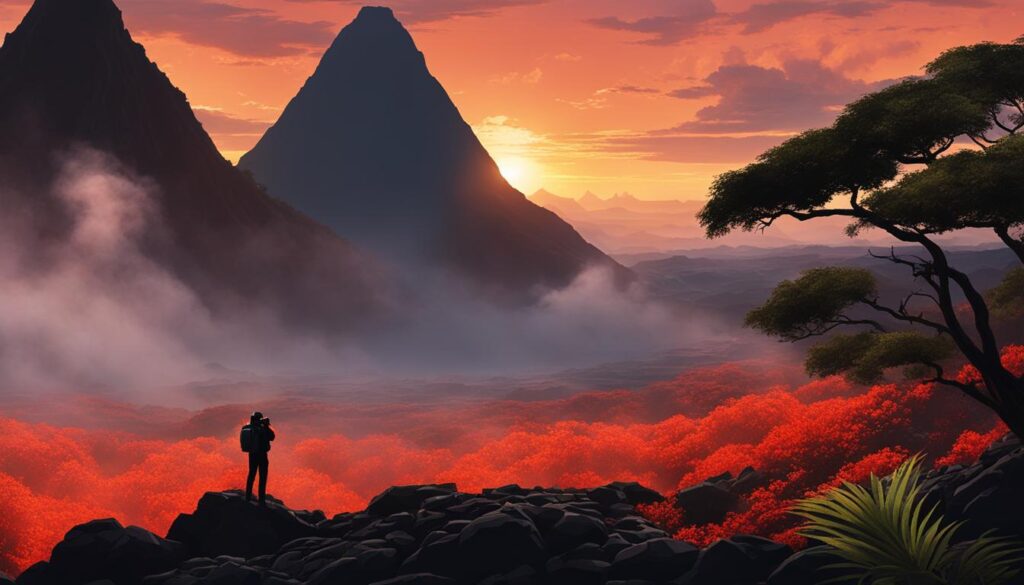
Table: Hawaii Volcanoes National Park Information
| Location | Big Island, Hawaii |
|---|---|
| Main Attractions | Active volcanoes, volcanic landscapes, lava flows |
| Best Time to Visit | Winter months for cooler temperatures and dramatic lighting |
| Photography Tips | Bring a tripod for long exposures, use a wide-angle lens to capture the expansive landscapes, and be prepared for changing weather conditions. |
In conclusion, the Hawaii Volcanoes National Park on the Big Island is a must-visit photography spot for capturing the unique volcanic landscapes and active volcanoes. Whether you choose to hike or drive, this park offers abundant opportunities to capture the raw beauty and power of nature. With its diverse environments and dramatic scenery, the Hawaii Volcanoes National Park is a true gem for photographers seeking extraordinary shots.
Maui: Road to Hana
Maui’s Road to Hana is a picturesque 64-mile stretch of highway that winds along the island’s pristine coastline, offering incredible photography opportunities. This famous road is famous for its breathtaking views, lush forests, majestic waterfalls, and charming beach towns. Whether you’re a professional photographer or just a hobbyist, the Road to Hana is a paradise for capturing stunning shots of Maui’s winter landscapes.
Scenic Stops and Photography Spots
Along the Road to Hana, there are numerous scenic stops and photography spots where you can capture the beauty of Maui’s natural wonders. From the breathtaking Garden of Eden to the stunning Twin Falls, each stop offers its own unique charm and photographic opportunities. Don’t forget to explore the black sand beaches of Waianapanapa State Park and the panoramic vistas of the Pools of Ohe’o in Haleakala National Park.
Photography Tips for the Road to Hana
To make the most of your photography experience along the Road to Hana, here are some helpful tips:
- Start early in the morning to beat the crowds and capture the soft morning light.
- Bring a tripod to steady your camera for long exposure shots of waterfalls and low-light scenes.
- Pack a wide-angle lens to capture the expansive landscapes and a telephoto lens for close-up shots of flowers and wildlife.
- Be prepared for changing weather conditions and carry rain gear to protect your equipment.
- Take your time and explore the lesser-known spots along the road to discover hidden gems for your photography.
By following these tips and exploring the Road to Hana with a camera in hand, you’ll have the opportunity to capture the breathtaking beauty of Maui’s winter landscapes and create memories that will last a lifetime.
Kauai: Waimea Canyon
Kauai, often referred to as the “Garden Isle,” offers a plethora of stunning photography spots, and one of the most iconic locations is Waimea Canyon. Known as the “Grand Canyon of Hawaii,” this breathtaking natural wonder is a must-visit for photographers looking to capture the beauty of Kauai during the winter season.
With its deep reds, vibrant browns, and dramatic landscapes, Waimea Canyon provides an awe-inspiring backdrop for your photography. The best time to capture the canyon’s vibrant colors is during the late afternoon when the lighting is optimal. Whether you’re an amateur or professional photographer, Waimea Canyon will undoubtedly leave you in awe of its beauty.
Exploring Waimea Canyon offers endless opportunities to capture stunning shots. From panoramic views to close-ups of the canyon’s intricate details, every angle presents a unique perspective. Don’t forget to bring your wide-angle lens to capture the vastness of the canyon and telephoto lens to highlight the intricate textures and colors.
As you immerse yourself in the natural beauty of Waimea Canyon, remember to take your time, embrace the serenity of the surroundings, and let your creativity soar. Whether you’re visiting Kauai for the first time or returning to this enchanting island, Waimea Canyon is a must-visit photography spot that will undoubtedly leave you with captivating images to cherish for a lifetime.
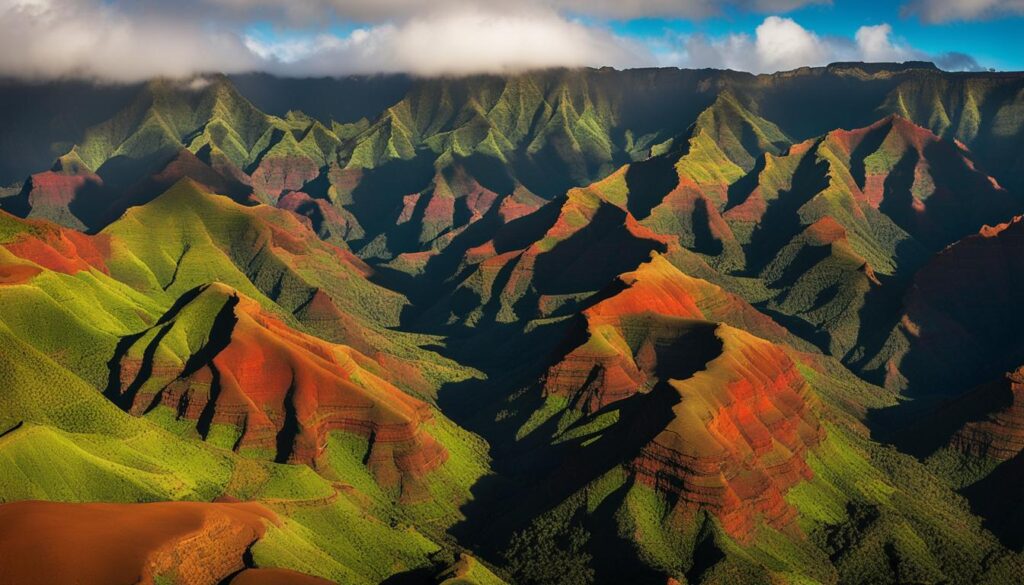
Capturing the Beauty of Waimea Canyon
| Tips for Photographers | Equipment | Recommended Settings |
|---|---|---|
| 1. Plan your visit during the late afternoon to capture the vibrant colors of the canyon. | – Wide-angle lens to capture the vastness of the canyon – Telephoto lens for close-ups of intricate details – Tripod for stability and long-exposure shots – Polarizing filter to reduce glare and enhance colors |
– Aperture: f/8 to f/11 for optimal depth of field – ISO: Low ISO (100-200) for best image quality – Shutter speed: Adjust based on lighting conditions |
| 2. Explore different viewpoints along the canyon rim for varied perspectives. | – Camera bag or backpack to carry your equipment – Extra memory cards and batteries for extended shooting – Lens cleaning kit to keep your gear in pristine condition |
– Shoot in RAW format for maximum flexibility during post-processing – Use autofocus or manual focus depending on your preferences and the scene – Experiment with different white balance settings to capture the canyon’s unique colors |
| 3. Keep an eye out for wildlife and incorporate it into your compositions for added interest. | – Camera remote or cable release for long-exposure shots – Graduated ND filter to balance exposure between the sky and canyon |
– Bracket your shots to capture a wider dynamic range if the lighting is challenging – Experiment with different compositions and angles to create visually compelling images – Don’t forget to enjoy the experience and take some time to simply appreciate the beauty of Waimea Canyon |
Lanai: Shipwreck Beach
Lanai, a remote and lesser-known island in Hawaii, offers unique photography opportunities, and Shipwreck Beach is a standout location. Accessible only on foot or by jeep, this beach is home to a WWII tanker wreck sitting just offshore. The wreck provides a fascinating subject for photographers, and the panoramic views of the islands of Molokai and Maui add to the stunning backdrop. Shipwreck Beach is a hidden gem for photographers seeking off-the-beaten-path locations in Hawaii.
Photography Spotlight: Shipwreck Beach
Shipwreck Beach on Lanai is a must-visit for photographers looking to capture the rugged beauty of Hawaii’s lesser-explored landscapes. The beach, dotted with rusted remnants of a shipwreck, offers a unique and intriguing subject for photography. Whether you prefer capturing close-up details of the wreckage or wide-angle shots against the backdrop of dramatic cliffs and crystal-clear waters, Shipwreck Beach provides endless opportunities for creativity.
Best Time to Visit
The best time to visit Shipwreck Beach for photography is during the golden hours of sunrise and sunset. The warm, soft light enhances the textures and colors of the wreckage and surrounding landscape, creating a truly mesmerizing scene. Additionally, visiting during low tide allows for better access to the shipwreck and the opportunity to capture striking reflections on the wet sand. Be sure to check the tide schedules before planning your photography session.
| Photography Tips for Shipwreck Beach, Lanai |
|---|
| 1. Experiment with different angles and perspectives to capture the unique character of the shipwreck. |
| 2. Include elements of the surrounding landscape, such as the cliffs or nearby islands, to add depth and context to your photos. |
| 3. Incorporate the play of light and shadow to create dramatic and visually interesting compositions. |
| 4. Consider using wide-angle lenses to capture the expansive views and wide open spaces of Shipwreck Beach. |
Molokai: Kapuaiwa Coconut Grove
Molokai, known for its untouched beauty and serene atmosphere, offers a hidden gem for photographers – the Kapuaiwa Coconut Grove. This historic site, once a royal coconut grove, is a captivating location for capturing stunning shots. The tall coconut trees and breathtaking sunset views provide a picturesque backdrop for your photography adventures in Molokai.
Visiting the Kapuaiwa Coconut Grove during the winter season allows you to witness the natural beauty of the grove in a tranquil setting. The soft golden light of the setting sun adds warmth and depth to your photographs, creating a dreamy atmosphere. It’s the perfect opportunity to experiment with different angles, compositions, and lighting techniques to capture the essence of this enchanting place.
As you explore the Kapuaiwa Coconut Grove, keep an eye out for interesting details and textures. The gnarled trunks of the coconut trees, the fallen coconuts on the ground, and the intricate patterns on the bark all provide unique elements to enhance your photographs. Don’t be afraid to get up close and personal with your subjects, capturing the intricate beauty that lies within this hidden paradise.
So pack your camera gear and head to Molokai’s Kapuaiwa Coconut Grove for a photography adventure you won’t forget. Immerse yourself in the serenity of this historic site and let your creativity flow as you capture the beauty of Molokai during the winter season.
Best Beaches for Winter Photography in Hawaii
When it comes to capturing the beauty of Hawaii during winter, the stunning beaches of the islands offer endless photography opportunities. From the breathtaking black sands of Punalu’u Beach on the Big Island to the pristine powdered sugar sands of Lanikai Beach on Oahu, each island boasts its own unique beach photography spots to explore. Whether you’re looking to capture vibrant sunset scenes, coastal landscapes, or even encounters with wildlife, Hawaii’s beaches have it all.
Here are some of the best beaches for winter photography in Hawaii:
- Punalu’u Beach: Located on the Big Island, Punalu’u Beach is famous for its striking black sands and turquoise waters. The contrast of the dark sand against the ocean creates stunning visuals, especially during golden hour.
- Lanikai Beach: Situated on Oahu’s eastern shore, Lanikai Beach is renowned for its picturesque beauty. With its calm turquoise waters and powdery white sands, it’s the perfect spot for capturing serene beach scenes.
- Kee Beach: Found on the north shore of Kauai, Kee Beach is known for its dramatic cliffs, lush greenery, and crystal-clear waters. It’s an ideal location for capturing the rugged beauty of the island.
- Kapalua Beach: Located on Maui, Kapalua Beach offers stunning views of the neighboring islands and vibrant sunsets. The golden sands and swaying palm trees add to the tropical paradise ambiance, making it a favorite among photographers.
Exploring these beautiful beaches during the winter season in Hawaii allows photographers to capture the unique charm and natural beauty of the islands. Whether you’re a professional photographer or an amateur enthusiast, be sure to pack your camera and capture the magic of Hawaii’s winter beaches.
National Parks and Scenic Lookouts in Hawaii
Hawaii is blessed with stunning national parks and scenic lookouts that offer breathtaking photography opportunities. These protected areas showcase the unique landscapes and wildlife of the islands, providing photographers with a chance to capture the beauty of Hawaii’s natural wonders during the winter months.
One of the must-visit national parks is Hawaii Volcanoes National Park on the Big Island. This park allows photographers to witness the raw power of active volcanoes and capture dramatic volcanic landscapes. The Crater Rim Drive and Chain of Craters Road offer scenic routes for exploring the park and finding the perfect spot for your winter photography.
Another iconic location is Haleakala National Park on Maui. Known for its mesmerizing sunrises, this park provides a surreal backdrop for capturing stunning photographs. From the summit of Haleakala, you can admire panoramic views of the island and its diverse ecosystems.
| National Parks | Highlights |
|---|---|
| Hawaii Volcanoes National Park | – Active volcanoes – Dramatic volcanic landscapes – Scenic drives |
| Haleakala National Park | – Breathtaking sunrises – Panoramic views – Diverse ecosystems |
Aside from the national parks, Hawaii is also home to numerous scenic lookouts that offer panoramic views of the islands’ beauty. Diamond Head on Oahu provides a stunning vista of the coastline, while the Waimea Canyon Lookout on Kauai offers breathtaking views of the “Grand Canyon of Hawaii.” These lookout points allow photographers to capture the vastness and splendor of the Hawaiian landscapes.
When exploring the national parks and scenic lookout points in Hawaii, be sure to plan your visits and consider weather conditions for the best photography opportunities. The winter months offer unique lighting and atmospheric conditions that can enhance your photographs and create stunning visual effects.
Hawaii National Parks and Lookouts:
- Hawaii Volcanoes National Park – Active volcanoes, dramatic landscapes, scenic drives
- Haleakala National Park – Breathtaking sunrises, panoramic views, diverse ecosystems
- Diamond Head Lookout – Stunning coastal views on Oahu
- Waimea Canyon Lookout – Breathtaking views of the “Grand Canyon of Hawaii” on Kauai
Cultural and Historical Sites in Hawaii for Photography
Hawaii not only offers breathtaking natural beauty but also boasts a rich cultural and historical heritage that provides amazing photography opportunities. Immersing yourself in these cultural sites allows you to capture meaningful moments that reflect the unique heritage of Hawaii. From ancient temples to significant historical landmarks, here are some of the cultural and historical sites in Hawaii that are perfect for photography:
1. Pearl Harbor National Memorial, Oahu
Visit the Pearl Harbor National Memorial on Oahu to pay tribute to the events that unfolded during World War II. Capture powerful images of the USS Arizona Memorial, the USS Missouri Battleship, and the Pacific Aviation Museum. These sites offer a chance to honor the past and capture the historical significance of this pivotal moment in history.
2. Polynesian Cultural Center, Laie
Experience the vibrant cultures of Hawaii and the Pacific Islands at the Polynesian Cultural Center in Laie. Photograph traditional dances, intricate costumes, and authentic cultural practices. Explore the diverse Polynesian villages and capture the spirit of aloha as you learn about the rich heritage of Hawaii and its neighboring islands.
3. Iolani Palace, Honolulu
Step back in time at the Iolani Palace, the only royal palace in the United States. This architectural marvel showcases the opulence and grandeur of Hawaiian monarchy. Capture the grand staircase, elegant rooms, and beautiful grounds as you document this important piece of Hawaiian history.
4. Pu’uhonua o Honaunau National Historical Park, Big Island
Explore the Pu’uhonua o Honaunau National Historical Park on the Big Island and capture the ancient Hawaiian way of life. Photograph the reconstructed thatched huts, sacred temples, and traditional fishponds. This site offers a glimpse into Hawaii’s rich cultural past and provides a serene and picturesque backdrop for your photography.
| Cultural and Historical Sites in Hawaii | Location | Highlights |
|---|---|---|
| Pearl Harbor National Memorial | Oahu | USS Arizona Memorial, USS Missouri Battleship, Pacific Aviation Museum |
| Polynesian Cultural Center | Laie | Traditional dances, cultural practices, diverse Polynesian villages |
| Iolani Palace | Honolulu | Grand staircase, elegant rooms, beautiful grounds |
| Pu’uhonua o Honaunau National Historical Park | Big Island | Reconstructed thatched huts, sacred temples, traditional fishponds |
Tips for Winter Photography in Hawaii
Capturing the beauty of Hawaii during winter is a photographer’s dream come true. With stunning landscapes and vibrant sunsets, the islands offer endless opportunities for capturing breathtaking images. To make the most of your winter photography adventures in Hawaii, here are some helpful tips:
1. Plan your shots
Before heading out, research the best photography spots in each island and plan your itinerary accordingly. Consider the weather conditions and the time of day for optimal lighting. By planning ahead, you’ll be able to maximize your time and capture the scenes you envision.
2. Experiment with different angles
Don’t be afraid to get creative with your compositions. Hawaii’s landscapes offer a variety of interesting elements, such as lava rocks, palm trees, and waterfalls. Try shooting from different angles and perspectives to add depth and uniqueness to your photos.
3. Capture the local culture
In addition to the scenic beauty, Hawaii’s culture is rich and vibrant. Don’t miss the opportunity to capture the essence of the islands through photographs of local traditions, festivals, and cultural sites. Incorporating these elements into your shots will add a unique storytelling aspect to your winter photography.
4. Embrace the challenging lighting conditions
Winter in Hawaii can bring unpredictable weather, including cloudy or rainy days. Instead of being disappointed, use these conditions to your advantage. Cloudy skies can create a soft and diffused light that is perfect for capturing moody and atmospheric shots. Rain can add a reflective quality to surfaces, enhancing colors and providing interesting textures.
With these tips in mind, you’re ready to embark on your winter photography journey in Hawaii. Remember to pack your camera gear, dress appropriately for the weather, and immerse yourself in the beauty and culture of the islands. Happy shooting!
FAQ
What are the best photography spots in Hawaii during winter?
The best photography spots in Hawaii during winter include Ho’omaluhia Botanical Garden in Oahu, Hawaii Volcanoes National Park on the Big Island, Road to Hana in Maui, Waimea Canyon in Kauai, Shipwreck Beach in Lanai, Kapuaiwa Coconut Grove in Molokai, and various beaches, national parks, and cultural sites.
Where is Ho’omaluhia Botanical Garden located?
Ho’omaluhia Botanical Garden is located in Oahu, Hawaii.
What can I expect to see at Hawaii Volcanoes National Park?
Hawaii Volcanoes National Park on the Big Island offers diverse landscapes, including mountains, valleys, jungles, and active volcanoes.
Where is Road to Hana located?
Road to Hana is located in Maui, Hawaii.
What is Waimea Canyon known for?
Waimea Canyon in Kauai is known as the “Grand Canyon of Hawaii” and offers breathtaking views and vibrant colors.
How can I access Shipwreck Beach in Lanai?
Shipwreck Beach in Lanai is accessible only on foot or by jeep.
Where is Kapuaiwa Coconut Grove located?
Kapuaiwa Coconut Grove is located in Molokai, Hawaii.
Are there any specific beaches recommended for winter photography in Hawaii?
Yes, some recommended beaches for winter photography in Hawaii include Punalu’u Beach on the Big Island and Lanikai Beach on Oahu.
Are there any national parks or scenic lookouts in Hawaii for photography?
Yes, Hawaii has several national parks and scenic lookouts that offer great photography opportunities, such as Hawaii Volcanoes National Park on the Big Island and Diamond Head on Oahu.
Are there any cultural and historical sites in Hawaii that are worth photographing?
Yes, places like Pearl Harbor National Memorial on Oahu and the Polynesian Cultural Center in Laie offer unique cultural and historical photography opportunities.
What are some tips for winter photography in Hawaii?
Some tips for winter photography in Hawaii include planning your shots in advance, allocating enough time for each location, capturing the best lighting conditions, and being prepared for weather changes.
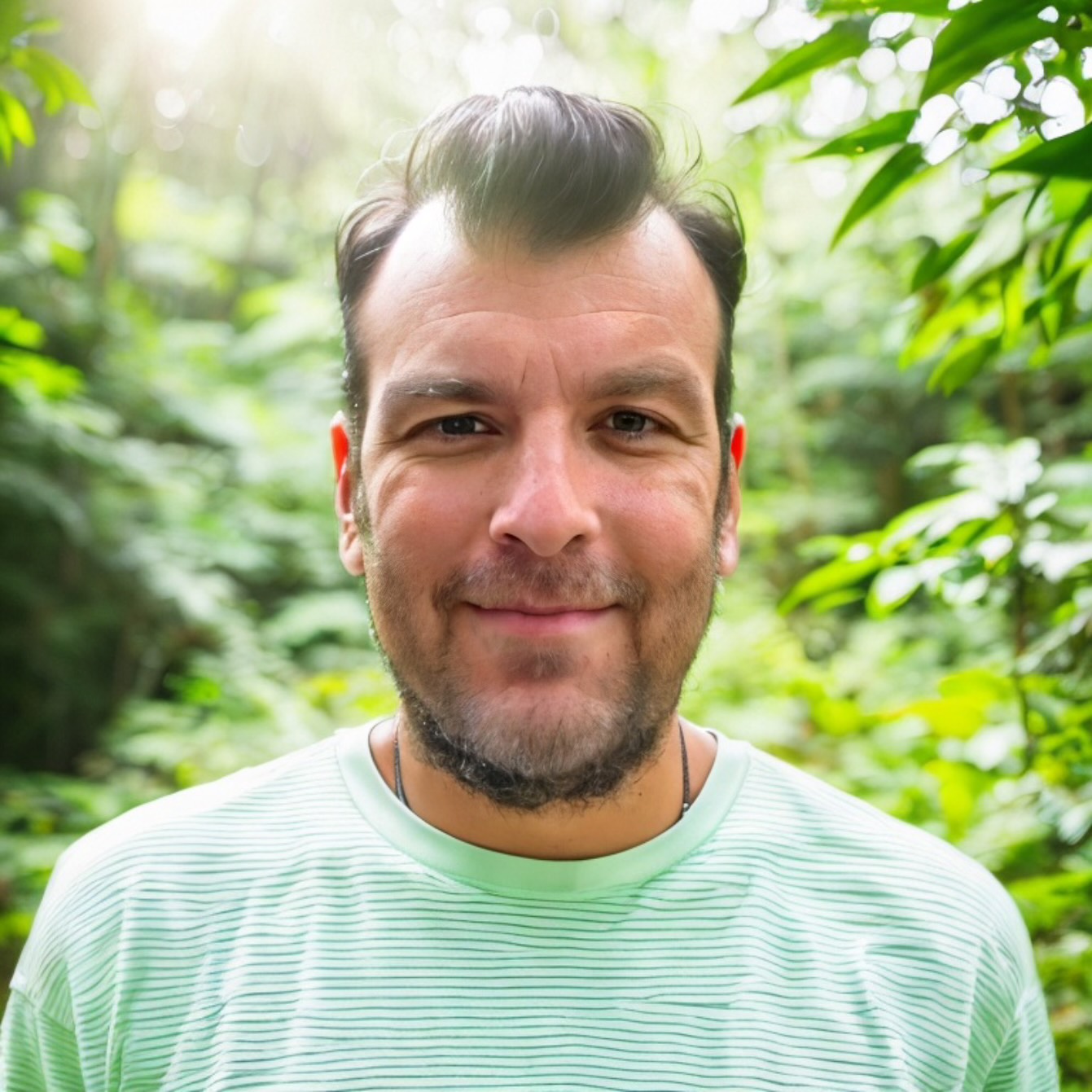
Scott Sweeney is the creator of Virtual Hawaii 360. Scott is a professional marketer and a lifelong Hawaii enthusiast. Scott splits time between Oahu and Dayton, Ohio. In addition to his marketing endevours, he is also a published Ukulele musician.

